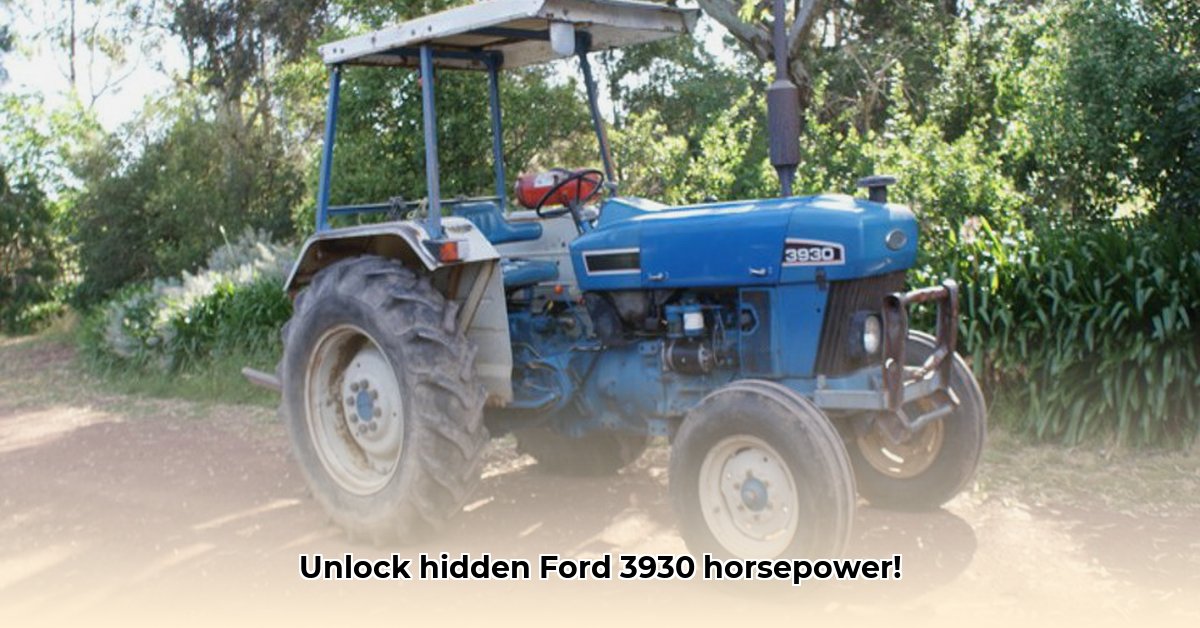
3930 Ford Tractor Horsepower: A Deep Dive into Performance
The Ford 3930, and its later Ford-New Holland 3930 iteration, represents a significant chapter in agricultural machinery history. This guide provides a comprehensive overview of its horsepower, performance capabilities, and maintenance considerations, targeting potential buyers, current owners, collectors, and enthusiasts alike. Understanding the nuances of this tractor's power and functionality is crucial for maximizing its efficiency and longevity. For more on Ford tractor horsepower, see this helpful resource: Ford Tractor HP.
Engine Power: Deciphering the Horsepower Numbers
The Ford 3930's power source stemmed from either a 3.3-liter or a 3.2-liter three-cylinder diesel engine. While sources cite varying horsepower figures – likely due to manufacturing tolerances and testing methodologies – a reasonable operational range can be established. This variation underscores the importance of consulting your specific tractor's documentation for precise specifications. Did you know that even minor engine modifications can affect the final horsepower output?
Transmission and PTO: Fine-Tuning Power Delivery
The 3930 boasted various transmissions, including an eight-speed and an eight-speed synchronized shuttle transmission. The latter offered improved control and smoother operation, particularly beneficial for tasks requiring precise speed adjustments. The Power Take-Off (PTO) horsepower, crucial for powering implements like hay balers and mowers, typically fell between 45 and 52 horsepower, varying slightly based on engine and model year. How crucial is the choice of transmission to your agricultural workflow?
Model Variations: Tailoring to Your Needs
The Ford 3930 offered both two-wheel-drive (2WD) and four-wheel-drive (4WD) configurations. The 2WD model was well-suited for lighter tasks and flatter terrain, while the 4WD provided superior traction in challenging conditions. This choice significantly impacts operational efficiency and capability. What terrain challenges does your farm present, and how does that influence the ideal drive configuration?
Hydraulic System: Powering Attachments and Implements
The hydraulic system—either open-center or closed-center—significantly influenced the responsiveness of attached implements. The three-point hitch delivered a consistent lift capacity of 3080 lbs (1397 kg), essential for handling various implements and attachments. Understanding your tractor's specific hydraulic setup is key to its safe and efficient operation. Could you accurately describe the differences between open-center and closed-center hydraulic systems, and how these differences impact the 3930's functionality?
Weight Variations: Understanding the Factors
Reported weights for the 3930 show some inconsistencies. This variability is primarily attributed to variations in optional equipment; a tractor with a front-end loader will weigh more than a basic model. This factor is important to remember when comparing specifications from different sources. What factors other than optional equipment could contribute to variations in the stated weight of the Ford 3930?
Maintenance and Troubleshooting: Ensuring Peak Performance
Regular maintenance is paramount to maximizing the Ford 3930's lifespan and efficiency. Proactive preventative maintenance significantly reduces the risk of costly repairs and prolonged downtime. "Preventative maintenance isn't just about keeping your tractor running; it's an investment in your farm's productivity," advises John Miller, a seasoned agricultural mechanic with over 30 years of experience.
A Step-by-Step Maintenance Plan:
- Engine Oil Changes: Regular oil changes (with the correct oil grade) and filter replacements are essential for optimal engine performance.
- Transmission Fluid: Routinely check transmission fluid levels and address any unusual noises promptly.
- Hydraulic System: Regularly monitor hydraulic fluid levels and inspect hoses for leaks.
- Electrical System: Monitor the battery and charging system; proactive battery replacement every few years is recommended.
Troubleshooting Common Problems:
Addressing issues promptly mitigates larger, more costly problems.
- Engine Starting Issues: Check the battery, starter motor, and fuel system.
- Hydraulic Leaks: Carefully inspect all hydraulic hoses, fittings, and cylinders.
- Transmission Problems: Unusual noises or difficulty shifting gears warrant immediate attention.
Parts Sourcing: Securing Essential Components
Parts availability for older tractors can be a challenge. Prioritize sourcing parts from reputable agricultural suppliers, online retailers specializing in classic machinery parts, or even salvage yards. Researching and securing parts ahead of time minimizes downtime. Developing a network of reliable parts suppliers is crucial for the long-term sustainability of your Ford 3930.
Comparison with Competitors: Assessing Performance
The Ford 3930 competed against notable tractors from John Deere, Massey Ferguson, and Case IH. While direct horsepower comparisons between models can be misleading due to variations in testing standards, the 3930 offered a compelling balance of power, versatility, and maneuverability suitable for a wide array of farm tasks.
Conclusion: The Enduring Legacy of the Ford 3930
The Ford 3930 remains a valuable asset for many agricultural operations. Its robust design, coupled with diligent maintenance, ensures long-term dependability. Understanding its capabilities and potential challenges ensures its continued contribution to efficient and productive farming. Investing in the right maintenance practices is investing in the longevity of your farm's operations.